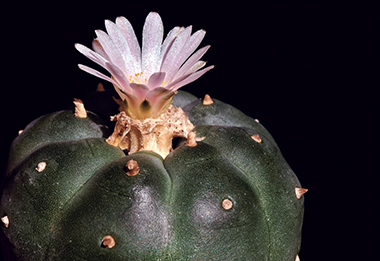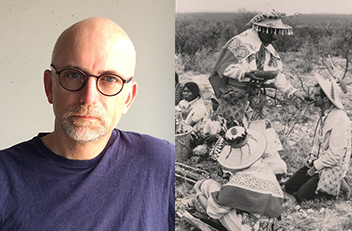The Tale of a Drug
 |
|
A close-up of the small spineless peyote cactus. |
ALBANY, N.Y. (Feb. 27, 2019) — The history of the mild hallucinogen peyote over the past four centuries in the Americas could mainly consist of a chronicle of key events, but in the hands of Alexander Dawson of History, it is a multi-faceted tale replete with textures about right, wrong and the complex nature of human needs and intentions.
In The Peyote Effect: from the Inquisition to the War on Drugs, released in late 2018 from University of California Press, Dawson takes us back and forth through time across the U.S.-Mexico border, exploring the battles in each country over who might have the right to consume the drug, or to use this little cactus plant, and the psychedelic alkaloid mescaline it produces, as part of a worship system. In each country, but in very different ways, we see how these conflicts helped produce racially exclusionary systems.
Dawson unfolds this bi-national history, particularly of the period from 1833 to the present decade, by touching on all aspects of the recreational and spiritual consumption (and the meanings) of peyote, as well as the legal forces that tried to limit both its study and use. The reader witnesses the racial thinking of both Euro-American and indigenous actors that linked the two countries more closely than we might have otherwise imagined.
Dawson, an associate professor who joined the University in the fall of 2017, was often startled by his findings in his research, just as his readers would be now.
Many Sides to Human Prejudice
“One thing that surprised me was the realization that, no matter how different the U.S. and Mexico are in some really substantial ways, the story of peyote and race in both countries is more intertwined and intersecting than I had thought it would be,” said Dawson. “I began with an idea that I would write about how different the U.S. and Mexico are, and I think that in the end I sort of argued the opposite.
 |
|
Historian Alexander Dawson and an outsider, seen on his knees, making a pilgrimage to the Huichol people of Mexico in the 1970s. |
“I am a historian, and so I am trained to look at stories about change over time. I kept struggling to find change over time here, and was instead struck by the fact that a series of similar struggles plays out again and again.”
Ultimately, there is something in this book of history that reveals the human condition — not in a glowing portrait, to be sure, but with an understanding of a common fear of "the other."
This is true in Dawson’s handling of racial prejudice (he is an expert of what he calls “the history of race and indignity in Mexico”). We see Euro-Americans in both nations prohibiting non-indigenous people's use of peyote — even for the study of the drug for medicinal purposes — by consigning it as "an Indian thing." But we also see indigenous peoples condemning whites, and even, poignantly at the book's conclusion, an African-American pastor, for wanting to make peyote part of their spiritual lives.
“I had thought that race worked very differently in Mexico and the U.S. — Mexicanists typically claim racism is more about culture in Mexico, and more about blood in the U.S. In the end, while I think it is not one story but a series of interlocking ones, I think I realized that when we focus on the U.S. versus Mexico as our basis for comparison, we miss the most important and interesting stories.”
Psychedelics and Faith
Dawson had another alteration of thought when it came to exploring the more modern psychedelic enthusiasts of peyote. The drug, largely confined to indigenous Mexicans and American Indian tribes for centuries, went mainstream with the U.S. youth culture of the ‘60s. Dawson was initially skeptical of these non-indigenous dope users — so much so that he realized “this was something I brought with me to the writing of the book, even if I did not really believe it when I started.
“But then I started talking to all these people in Mexico and in the U.S. and ultimately elsewhere, who described their experience with peyote and other psychedelics as personally transformative, and almost invariably in a deeply positive way. I realized, while listening to these people, that it was really important that I listen carefully, that I take their experiences seriously, and that I treat their stories with the same respect I offered to other subjects of the book.”
* * * * * *
Dawson’s next project will again use one subject to branch out and address much larger societal issues. “It’s about the history of bike lanes in Mexico City, Vancouver, and Copenhagen,” he said, “and in particular about what these projects reveal about contemporary environmentalism, our weakening social bonds and life in increasingly unequal global cities.”
![]() For more news, subscribe to UAlbany's RSS headline feeds
For more news, subscribe to UAlbany's RSS headline feeds
A comprehensive public research university, the University at Albany-SUNY offers more than 120 undergraduate majors and minors and 125 master's, doctoral and graduate certificate programs. UAlbany is a leader among all New York State colleges and universities in such diverse fields as atmospheric and environmental sciences, business, education, public health,health sciences, criminal justice, emergency preparedness, engineering and applied sciences, informatics, public administration, social welfare and sociology, taught by an extensive roster of faculty experts. It also offers expanded academic and research opportunities for students through an affiliation with Albany Law School. With a curriculum enhanced by 600 study-abroad opportunities, UAlbany launches great careers.


